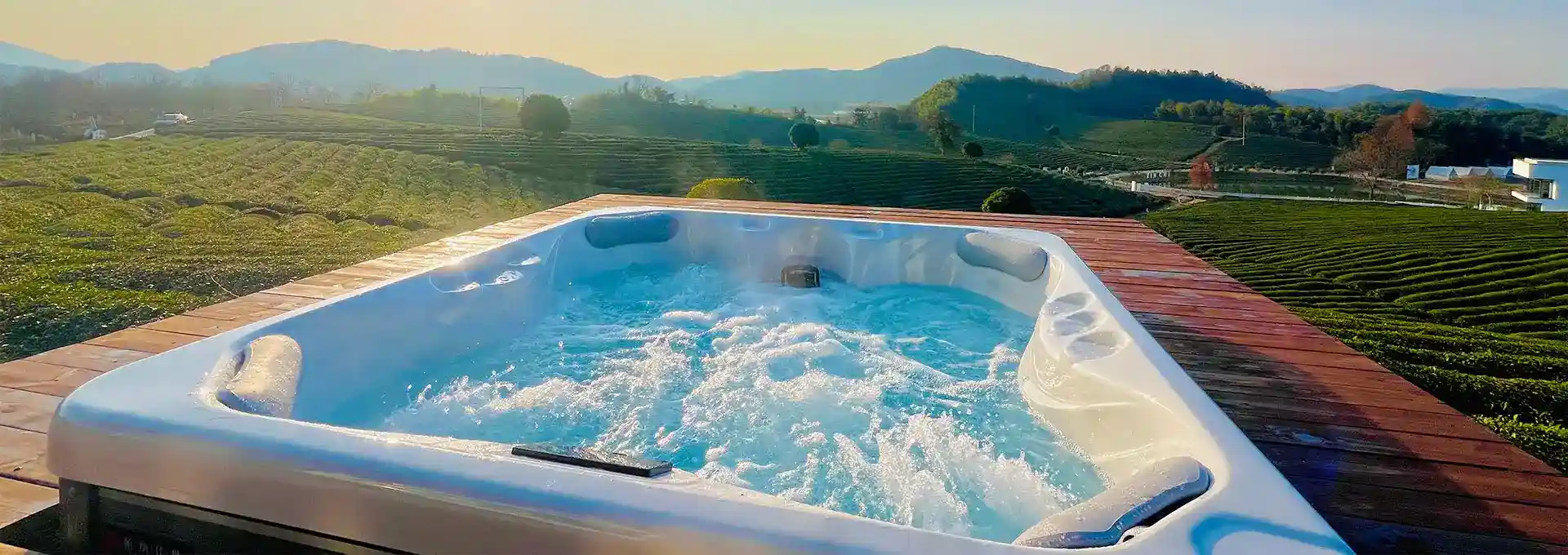Can You Put a Swim Spa Indoors?
2024-08-26 13:37:18
The serenity of a swim spa, typically associated with outdoor relaxation, can also be enjoyed within the comfort of an indoor space. But can you put a swim spa indoors? This question opens up a world of possibilities for year-round hydrotherapy and exercise, regardless of weather conditions. Indoor placement offers a unique set of advantages and challenges that are worth examining. This comprehensive guide will walk you through the process of deciding whether an indoor swim spa is right for you, including the features of dual-zone swim spas and the overall experience they provide.
What Are the Key Considerations for Indoor Swim Spa Placement?
Placing a swim spa indoors requires careful consideration of several factors to ensure a successful installation and enjoyable experience.
Space Requirements:
Measure the dimensions of the swim spa and evaluate the available indoor space to ensure a proper fit. It's crucial to account not just for the swim spa itself, but also for the surrounding area. You'll need space for entry and exit, as well as room for maintenance access. Consider the ceiling height as well – you'll want enough clearance for comfortable use and any potential accessories like overhead lighting or fans.
Floor Load Capacity:
The structural integrity of the floor must be assessed to handle the weight of the filled swim spa. This is a critical consideration that often requires professional evaluation. A typical Dual-Zone Swim Spa can weigh anywhere from 2,000 to 6,000 pounds when empty, and several times that when filled with water and occupied. You may need to reinforce the floor or even create a custom foundation to support this weight safely.
Ventilation and Air Quality:
Indoor swim spas produce humidity, so proper ventilation and air circulation are crucial to prevent mold and maintain air quality. This often involves installing a dedicated ventilation system or dehumidifier. Without adequate ventilation, you risk damage to your home's structure and potential health issues from poor air quality. Consider consulting with an HVAC specialist to design an appropriate system for your specific setup.
Electrical Requirements:
Ensure that the indoor space has the necessary electrical capacity to power the swim spa's systems. Most swim spas require a dedicated 220-240 volt circuit, and you may need to upgrade your electrical panel to accommodate this. Always hire a licensed electrician for this work to ensure safety and compliance with local codes.
Accessibility:
Consider how the swim spa will be accessed and whether any modifications are needed for ease of use. This might include adding non-slip flooring around the spa, installing handrails, or even creating a custom entry point. If you're planning to use the swim spa for therapeutic purposes, you might need to consider accessibility features for individuals with mobility challenges.
Aesthetic Integration:
The swim spa should blend with the existing indoor decor, becoming a functional and attractive feature of the home. This might involve custom cabinetry, tiling, or even creating a themed room around the swim spa. Consider lighting options that enhance both the functionality and ambiance of the space.
Water Management:
Indoor swim spas require a plan for filling, draining, and maintaining water quality. You'll need a convenient water source and a drainage system that can handle the volume of water in the spa. Consider installing a permanent filling and draining system to simplify maintenance.
Noise Considerations:
While swim spas are generally not excessively noisy, the sound of pumps and moving water can be more noticeable indoors. Consider sound insulation options if the swim spa is near living or sleeping areas.
How Does a Dual-Zone Swim Spa Function in an Indoor Setting?
Dual-zone swim spas offer distinct areas for swimming and relaxation, and their functionality in an indoor setting is multifaceted.
Swimming Zone:
The swimming zone provides a current for exercise similar to open-water swimming, adjustable to the swimmer's proficiency and desired intensity. In an indoor setting, this zone can be used year-round for consistent training or aquatic exercise routines. The controlled environment allows for precise adjustment of current strength, making it suitable for swimmers of all levels, from beginners to advanced athletes.
Relaxation Zone:
This area is designed for hydrotherapy, with jets targeting specific muscle groups to provide relaxation and stress relief. In an indoor setting, the relaxation zone becomes a personal oasis, available at any time for stress relief or recovery after a workout. The controlled indoor environment enhances the therapeutic experience, allowing users to fully relax without concerns about weather or privacy.
Temperature Control:
Dual-zone functionality extends to independent temperature control, allowing for personalized comfort levels in each zone. This feature is particularly beneficial in an indoor setting, where ambient temperatures are more consistent. Users can maintain a cooler temperature in the swim zone for vigorous exercise while keeping the relaxation zone warmer for therapeutic purposes.
Space Efficiency:
Even in a compact indoor space, dual-zone swim spas offer a versatile use of the available area, maximizing the benefits of hydrotherapy and exercise. This efficiency is particularly valuable in indoor settings where space may be at a premium. The dual-zone design allows multiple users to enjoy different activities simultaneously, making it an excellent option for families or households with diverse wellness needs.
Customizable Features:
Many dual-zone swim spas offer customizable features that can be tailored to the indoor environment. This might include programmable lighting systems, integrated audio systems, or even smart home integration for convenient control of spa functions.
Year-Round Training Opportunities:
For serious swimmers or athletes, an indoor dual-zone swim spa provides consistent training conditions regardless of outdoor weather. This can be particularly valuable for maintaining fitness routines or preparing for competitions.
Therapeutic Applications:
The controlled environment of an indoor setting enhances the therapeutic potential of the dual-zone swim spa. It can be used for rehabilitation exercises, low-impact fitness routines, or as part of a wellness program under the guidance of healthcare professionals.
What Are the Benefits and Challenges of Indoor Swim Spa Ownership?
Owning an indoor Dual-Zone Swim Spa comes with a unique set of benefits and challenges that should be weighed carefully.
Benefits:
Year-Round Use:
An indoor swim spa allows for swimming and relaxation without seasonal limitations. This consistent access can lead to improved fitness routines, better stress management, and enhanced overall well-being. It's particularly beneficial in regions with extreme weather conditions that might limit outdoor spa use.
Privacy:
Indoor placement offers a greater sense of privacy compared to outdoor setups. This can lead to more frequent and comfortable use, especially for those who might feel self-conscious about using an outdoor spa. The privacy factor also adds a layer of security, reducing concerns about unauthorized access or vandalism.
Consistent Conditions:
The temperature and conditions can be controlled, providing a comfortable experience every time. This consistency is not only more enjoyable but can also be beneficial for therapeutic uses or athletic training. It allows users to maintain precise routines without adjusting for weather variables.
Protection from Elements:
An indoor swim spa is shielded from sun, wind, rain, and debris, which can reduce maintenance requirements and extend the lifespan of the spa. This protection also means less time spent on cleaning and more time enjoying the spa.
Potential for Integration with Home Design:
An indoor swim spa can become a striking feature of your home's interior design. It can be incorporated into a dedicated wellness area, a home gym, or even a central living space, adding both functional and aesthetic value to your home.
Energy Efficiency:
In many cases, an indoor swim spa can be more energy-efficient than an outdoor one. The controlled environment helps maintain water temperature more consistently, potentially reducing heating costs.
Challenges:
Humidity Management:
The increased humidity from the Dual-Zone Swim Spa must be managed to prevent damage to the indoor environment. This often requires a significant investment in ventilation and dehumidification systems. Failure to adequately address humidity can lead to mold growth, wood rot, and other structural issues.
Cost of Installation:
Indoor installations may require more extensive modifications, such as floor reinforcement and ventilation systems, increasing the overall cost. The initial investment for an indoor swim spa setup is often higher than an outdoor installation due to these additional requirements.
Space Commitment:
An indoor swim spa requires dedicating a significant amount of interior space to a single purpose. This commitment might not be feasible for all homeowners and could impact the resale value of the home, depending on market preferences.
Potential for Water Damage:
While proper installation minimizes risks, there's always a potential for water damage with an indoor water feature. This risk necessitates vigilant maintenance and may impact home insurance considerations.
Limitations on Size and Features:
The size and features of an indoor swim spa may be limited by the available space and access points in your home. Larger models or those with extensive additional features might not be feasible for indoor installation.
Noise Considerations:
The sound of pumps and moving water may be more noticeable indoors, potentially impacting the peaceful atmosphere of your home. This might require additional soundproofing measures.
Maintenance Logistics:
While protected from outdoor elements, indoor swim spas still require regular maintenance. This includes water treatment, cleaning, and occasional repairs, which must be managed within the indoor space.
Conclusion
An indoor swim spa is not only a feasible addition to your home but also a luxurious one that can significantly enhance your lifestyle and well-being. With careful planning and consideration of space, structural, and environmental factors, you can enjoy the therapeutic and exercise benefits of a Dual-Zone Swim Spa in the comfort of your indoor living space. The dual-zone feature enhances this experience by offering both swimming and relaxation in one unit, making it a versatile investment for health and wellness.
However, the decision to install an indoor swim spa should not be taken lightly. It requires a significant commitment in terms of space, finances, and ongoing maintenance. The challenges of managing humidity, ensuring proper structural support, and integrating the spa into your home's design and systems are substantial but not insurmountable.
Ultimately, for those who value year-round access to aquatic exercise and relaxation, and who have the means to address the challenges, an indoor swim spa can be a rewarding addition to the home. It offers a unique combination of fitness, relaxation, and luxury that can enhance quality of life and potentially add value to your property.
Before making a decision, it's advisable to consult with professionals, including contractors, HVAC specialists, and swim spa dealers. They can provide detailed assessments of your space, help you understand the full scope of the project, and offer solutions tailored to your specific needs and home environment. With the right planning and execution, an indoor swim spa can become a cherished centerpiece of your home, offering years of enjoyment and wellness benefits.
If you want to get more information about this product, you can contact us at info@iparnassus.com!
References:
1. "Indoor Swim Spas: A Guide to Installation and Enjoyment." Home Wellness Digest
2. "The Allure of Indoor Hydrotherapy: Benefits and Considerations." Indoor Spa Review
3. "Designing Spaces for Indoor Swim Spas." Interior Design Ideas
4. "Electrical and Structural Requirements for Indoor Swim Spas." Home Structural Advisor
5. "Ventilation Strategies for Indoor Pools and Spas." Healthy Home Environments
6. "Maximizing the Use of Your Dual-Zone Swim Spa." Aquatic Fitness Magazine
7. "The Economic Impact of Indoor Swim Spa Ownership." Financial Wellness Journal
8. "Indoor vs. Outdoor Swim Spas: Which is Right for You?" Pool and Spa Choice
9. "Creating a Serene Indoor Swim Spa Experience." Relaxation at Home
10. "The Impact of Humidity on Indoor Air Quality." Environmental Control Systems



